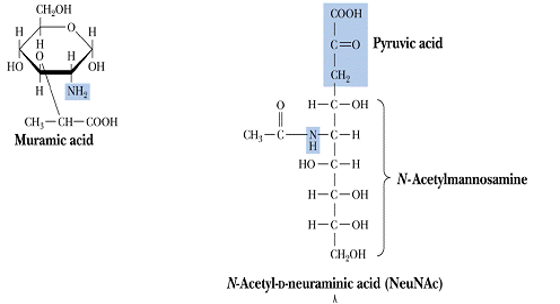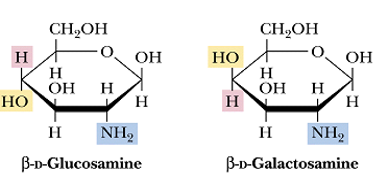Library
Chemical Nature of Sialic acid
- November 11, 2019
- Posted by: Namrata Chhabra
- Category: Chemistry of Biomolecules Chemistry of Carbohydrates Learning resources Library Multiple-choice questions Multiple-Choice questions USMLE Content USMLE Style questions USMLE styled question bank

The influenza virus infects cells by binding its viral hemagglutinin to “Sialic acid” on the surface of epithelial cells. Which of the following represents the true chemical nature of sialic acid?
A. Glycolipid
B. Amino sugar
C. Amino sugar acid
D. Lipoprotein
E. Glycoprotein.
Details
The correct answer is C- Amino sugar acid. Sialic acid is a sugar derivative.
Basic concept
Amino sugars
Amino groups may be substituted for the hydroxyl group of sugars to give rise to amino sugars. Generally, the amino group is added to the second carbon of the hexoses. The most common amino sugars are Glucosamine and Galactosamine (Figure-1). The amino group in the sugar may be further acetylated to produce N-acetylated sugars such as N-Acetyl Glucosamine (GluNac) and N-Acetyl-Galactosamine (GalNAc), etc.

Figure-1- Glucosamine and galactosamine are important constituents of glycoproteins, mucopolysaccharides, and cell membrane antigens.
Amino sugar acids are produced by condensation of amino sugar with Pyruvic or lactic acid. E.g. Muramic acid is produced by the condensation of lactic acid with D- Glucosamine. Certain bacterial cell walls contain Muramic acid.
N-Acetyl Neuraminic acid is formed from the condensation of Pyruvic acid with N-Acetyl Mannosamine (Figure-2). N-Acetyl Neuraminic acid (NANA), also called Sialic acid, is a nine carbon derivative and is an important component of glycoproteins and gangliosides (lipids). Neuraminidase is the enzyme that removes NANA from its binding with other compounds.

Figure-2- Structures of Muramic acid and Sialic acid.
As regards other options:
A. Glycolipids are compound lipids that contain carbohydrates and lipids. Cerebrosides and gangliosides are examples of glycolipids.
B. Amino sugar- explained above.
D. Lipoproteins are conjugated proteins, that contain lipid as a prosthetic group.
E. Glycoproteins- are also conjugated proteins that contain carbohydrates as a prosthetic group.
Author:Namrata Chhabra
Leave a Reply Cancel reply
You must be logged in to post a comment.
